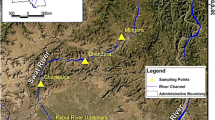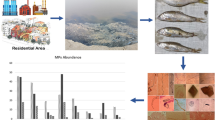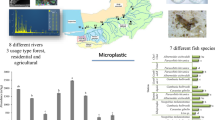Abstract
Microplastic (MP) pollution is an emerging environmental problem, due to its universal dispersion. In the present study, we determined the MP pollution in water, sediment, and fish samples of three different urban lakes of Bangladesh to assess the bioaccumulation of MPs from the lake environment to fish’s edible (flesh) and inedible tissue (gut), ecological risk and consequent human exposure to MPs by fish consumption. A total of forty-three fishes were collected from Jahangirnagar Co-Operative Housing Society (JCHS), Dhanmondi Lake (DL), and Saturia Thana Lake (MST). The average MP concentration in sediment and water of the lakes is 7588 ± 4353 MPs/kg dry weights; 142 ± 22 MPs/L, respectively. MPs were identified in the edible (2.8–20.2 MPs/g) and inedible (2.27–20.93 MPs/g) tissue of all fish species. The highest number of MPs was observed in the flesh of Labeo bata of the JCHS Lake and in the gut of Catla catla of DL. The most dominant shape of MPs was fiber and fragment, 0.1–0.4 mm was the dominant size range, and blue, purple, and transparent were the dominant colors. The presence of six polymer types was revealed by FT-IR analysis, which were polystyrene, polypropylene, nitrile, ethylene vinyl acetate, high-density polyethylene, and nylon. The concentration of MPs in fish is found to increase with the increment in body weight. The bioconcentration factor (BCF) analysis reveals that among all the fish species, Labeo bata and Oreochromis mossambicus accumulate the highest number of MPs from the lake environment. The pollution load index of MPs indicates that the sampling sites were within hazard levels III–IV. Estimated annual intake reveals that humans will be exposed to the highest number of MPs if they consume the flesh of Labeo bata of DL and JCHS Lake.
Graphical Abstract









Similar content being viewed by others
References
Abbasi S, Soltani N, Keshavarzi B et al (2018) Microplastics in different tissues of fish and prawn from the Musa Estuary, Persian Gulf. Chemosphere 205:80–87. https://doi.org/10.1016/j.chemosphere.2018.04.076
Afrin S, Uddin MK, Rahman MM (2020) Microplastics contamination in the soil from Urban Landfill site, Dhaka. Bangladesh. Heliyon 6. https://doi.org/10.1016/j.heliyon.2020.e05572
Akhbarizadeh R, Moore F, Keshavarzi B (2018) Investigating a probable relationship between microplastics and potentially toxic elements in fish muscles from northeast of Persian Gulf. Environ Pollut 232:154–163. https://doi.org/10.1016/j.envpol.2017.09.028
Andrady,AL (2011) Microplastics in the marine environment. Mar Pollut Bull 62(8):1596–1605. https://doi.org/10.1016/j.marpolbul.2011.05.030
Banik P, Hossain MB, Nur AAU et al (2022) Microplastics in sediment of Kuakata Beach, Bangladesh: occurrence, spatial distribution, and risk assessment. Front Mar Sci 9. https://doi.org/10.3389/fmars.2022.860989
Barboza LGA, Lopes C, Oliveira P et al (2020) Microplastics in wild fish from North East Atlantic Ocean and its potential for causing neurotoxic effects, lipid oxidative damage, and human health risks associated with ingestion exposure. Sci Total Environ 717:134625. https://doi.org/10.1016/j.scitotenv.2019.134625
de Sales-Ribeiro C, Brito-Casillas Y, Fernandez A, Caballero MJ (2020) An end to the controversy over the microscopic detection and effects of pristine microplastics in fish organs. Sci Rep 10:1–19. https://doi.org/10.1038/s41598-020-69062-3
Di M, Wang J (2018) Microplastics in surface waters and sediments of the Three Gorges Reservoir, China. Sci Total Environ 616–617:1620–1627. https://doi.org/10.1016/j.scitotenv.2017.10.150
Ding J, Zhang S, Razanajatovo RM et al (2018) Accumulation, tissue distribution, and biochemical effects of polystyrene microplastics in the freshwater fish red tilapia (Oreochromis niloticus). Environ Poll 238:1–9. https://doi.org/10.1016/j.envpol.2018.03.001
Duis K, Coors A (2016) Microplastics in the aquatic and terrestrial environment: sources (with a specific focus on personal care products), fate and effects. Environ Sci Eur 28:1–25
Dusaucy J, Gateuille D, Perrette Y, Naffrechoux E (2021) Microplastic pollution of worldwide lakes. Environ Poll 284:117075. https://doi.org/10.1016/j.envpol.2021.117075
Earn A, Bucci K, Rochman CM (2021) A systematic review of the literature on plastic pollution in the Laurentian Great Lakes and its effects on freshwater biota. J Great Lakes Res 47:120–133. https://doi.org/10.1016/j.jglr.2020.11.001
Faure F, Demars C, Wieser O, Kunz M, De Alencastro LF (2015) Plastic pollution in Swiss surface waters: Nature and concentrations, interaction with pollutants. Environ Chem 2015; 18(12):582–589
Gerolin CR, Pupim FN, Sawakuchi AO, Grohmann CH, Labuto G, Semensatto D (2020) Microplastics in sediments from Amazon rivers, Brazil. Sci Total Environ 749. https://doi.org/10.1016/j.scitotenv.2020.141604
Haque MR, Ali MM, Ahmed W et al (2023) Assessment of microplastics pollution in aquatic species (fish, crab, and snail), water, and sediment from the Buriganga River, Bangladesh: an ecological risk appraisals. Sci Total Environ 857. https://doi.org/10.1016/j.scitotenv.2022.159344
Hossain MS, Rahman MS, Uddin MN et al (2020) Microplastic contamination in Penaeid shrimp from the Northern Bay of Bengal. Chemosphere 238. https://doi.org/10.1016/j.chemosphere.2019.124688
Hossain MS, Sobhan F, Uddin MN et al (2019) Microplastics in fishes from the Northern Bay of Bengal. Sci Total Environ 690:821–830. https://doi.org/10.1016/j.scitotenv.2019.07.065
Hossain S, Rahman MA, Chowdhury MA, Mohonta SK (2021) Plastic pollution in Bangladesh: a review on current status emphasizing the impacts on environment and public health. Environ Eng Res 26
Isobe A, Kubo K, Tamura Y et al (2014) Selective transport of microplastics and mesoplastics by drifting in coastal waters. Mar Pollut Bull 89:324–330. https://doi.org/10.1016/j.marpolbul.2014.09.041
Jabeen K, Su L, Li J et al (2017) Microplastics and mesoplastics in fish from coastal and fresh waters of China. Environ Poll 221:141–149. https://doi.org/10.1016/j.envpol.2016.11.055
Jung MR, Horgen FD, Orski S v., et al (2018) Validation of ATR FT-IR to identify polymers of plastic marine debris, including those ingested by marine organisms. Mar Pollut Bull 127:704–716. https://doi.org/10.1016/j.marpolbul.2017.12.061
Karami A, Golieskardi A, Bin HY et al (2017) Microplastics in eviscerated flesh and excised organs of dried fish. Sci Rep 7:1–9. https://doi.org/10.1038/s41598-017-05828-6
Kasamesiri P, Thaimuangpho W (2020) Microplastics ingestion by freshwater fish in the Chi River, Thailand. Int J GEOMATE 18(67):114–119. https://doi.org/10.21660/2020.67.9110
Khan HMS, Setu S (2022) Microplastic ingestion by fishes from Jamuna River, Bangladesh. Environ Nat Resour J 20:157–167. https://doi.org/10.32526/ennrj/20/202100164
Kor K, Ghazilou A, Ershadifar H (2020) Microplastic pollution in the littoral sediments of the northern part of the Oman Sea. Mar Pollut Bull 155. https://doi.org/10.1016/j.marpolbul.2020.111166
Koongolla JB, Lin L, Pan YF, Yang CP, Sun DR, Liu S, Xu XR, Maharana D, Huang JS, Li HX (2020) Occurrence of microplastics in gastrointestinal tracts and gills of fish from Beibu Gulf, South China Sea. Environ Pollut 258:113734. https://doi.org/10.1016/j.envpol.2019.113734
Li R, Yu L, Chai M et al (2020) The distribution, characteristics and ecological risks of microplastics in the mangroves of Southern China. Environ Eng Res 708. https://doi.org/10.1016/j.scitotenv.2019.135025
Lusher AL, McHugh M, Thompson RC (2013) Occurrence of microplastics in the gastrointestinal tract of pelagic and demersal fish from the English Channel. Mar Pollut Bull 67(1–2):94–99. https://doi.org/10.1016/j.marpolbul.2012.11.028
Makhdoumi P, Hossini H, Nazmara Z et al (2021) Occurrence and exposure analysis of microplastic in the gut and muscle tissue of riverine fish in Kermanshah province of Iran. Mar Pollut Bull 173. https://doi.org/10.1016/j.marpolbul.2021.112915
Meeker JD, Sathyanarayana S, Swan SH (2009) Phthalates and other additives in plastics: human exposure and associated health outcomes. Philos Trans Royal Soc B: Bio Sci 364:2097–2113. https://doi.org/10.1098/rstb.2008.0268
Mercy FT, Alam AKMR, Akbor MA (2022) Abundance and characteristics of microplastics in major urban wetlands of Dhaka, Bangladesh. https://doi.org/10.21203/rs.3.rs-1455552/v1
Mourshed M, Masud MH, Rashid F, Joardder MUH (2017) Towards the effective plastic waste management in Bangladesh: a review. Environ Sci Poll Res 24:27021–27046
Noda I, Dowrey AE, Haynes JL, Marcott C (2007) Group frequency assignments for major infrared bands observed in common synthetic polymers. In: Physical Properties of Polymers Handbook. Springer, New York, New York, NY, pp 395–406
Pan Z, Liu Q, Jiang R et al (2021) Microplastic pollution and ecological risk assessment in an estuarine environment: the Dongshan Bay of China. Chemosphere 262. https://doi.org/10.1016/j.chemosphere.2020.127876
Parvin F, Hassan MA, Tareq SM (2022a) Risk assessment of microplastic pollution in urban lakes and peripheral Rivers of Dhaka, Bangladesh. J Hazard Mater Adv 8:100187. https://doi.org/10.1016/j.hazadv.2022.100187
Parvin F, Jannat S, Tareq SM (2021) Abundance, characteristics and variation of microplastics in different freshwater fish species from Bangladesh. Sci Total Environ 784:147137. https://doi.org/10.1016/j.scitotenv.2021.147137
Parvin F, Nath J, Hannan T, Tareq SM (2022b) Proliferation of microplastics in commercial sea salts from the world longest sea beach of Bangladesh. Environ Adv 7. https://doi.org/10.1016/j.envadv.2022.100173
Pegado T de S e S, Schmid K, Winemiller KO, Chelazzi D, Cincinelli A, Dei L, Giarrizzo T (2018) First evidence of microplastic ingestion by fishes from the Amazon River estuary. Mar Pollut Bull 133:814–821. https://doi.org/10.1016/j.marpolbul.2018.06.035
Rao PG (2018) Food and feeding habits of freshwater fish Labeo Bata (HAMILTON, 1822) from the river Godavari Online. IJPBS 8:2230–7605
Romeo T, Pietro B, Pedà C et al (2015) First evidence of presence of plastic debris in stomach of large pelagic fish in the Mediterranean Sea. Mar Pollut Bull 95:358–361. https://doi.org/10.1016/j.marpolbul.2015.04.048
Shetu MH, Parvin F, Tareq SM (2023) Identifying the presence of microplastics in frogs from the largest delta of the world. Environ Adv:11
Su L, Deng H, Li B et al (2019) The occurrence of microplastic in specific organs in commercially caught fishes from coast and estuary area of east China. J Hazard Mater 365:716–724. https://doi.org/10.1016/j.jhazmat.2018.11.024
Sultan MB, Rahman MM, Khatun MA et al (2023) Microplastics in different fish and shellfish species in the mangrove estuary of Bangladesh and evaluation of human exposure. Sci Total Environ 858. https://doi.org/10.1016/j.scitotenv.2022.159754
Tanaka K, Takada H (2016) Microplastic fragments and microbeads in digestive tracts of planktivorous fish from urban coastal waters. Sci Rep 6:1–8. https://doi.org/10.1038/srep34351
Tomlinson DL, Wilson JG, Harris CR, Jeffrey DW (1980) Problems in the assessment of heavy-metal levels in estuaries and the formation of a pollution index, vol 33
Wang G, Lu J, Li W et al (2021) Seasonal variation and risk assessment of microplastics in surface water of the Manas River Basin, China. Ecotoxicol Environ Saf 208. https://doi.org/10.1016/j.ecoenv.2020.111477
Wang WX (2016) Bioaccumulation and biomonitoring. In: Marine Ecotoxicology: Current Knowledge and Future Issues. Elsevier, pp 99–119
Wassenaar PNH, Verbruggen EMJ, Cieraad E et al (2020) Variability in fish bioconcentration factors: influences of study design and consequences for regulation. Chemosphere 239. https://doi.org/10.1016/j.chemosphere.2019.124731
Xu P, Peng G, Su L et al (2018) Microplastic risk assessment in surface waters: a case study in the Changjiang Estuary, China. Mar Pollut Bull 133:647–654. https://doi.org/10.1016/j.marpolbul.2018.06.020
Yang L, Chen P, He K et al (2022) Predicting bioconcentration factor and estrogen receptor bioactivity of bisphenol a and its analogues in adult zebrafish by directed message passing neural networks. Environ Int 169. https://doi.org/10.1016/j.envint.2022.107536
Yang D, Shi H, Li L, Li J, Jabeen K, Kolandhasamy P (2015) Microplastic pollution in table salts from China. Environ Sci Technol 49(22):13622–13627. https://doi.org/10.1021/acs.est.5b03163
Yin K, Wang D, Zhao H et al (2021) Microplastics pollution and risk assessment in water bodies of two nature reserves in Jilin Province: correlation analysis with the degree of human activity. Sci Total Environ 799. https://doi.org/10.1016/j.scitotenv.2021.149390
Zhang W, Cai Y, Tu C, Ma LQ (2002) Arsenic speciation and distribution in an arsenic hyperaccumulating plant. Sci Total Environ 300(1-3):167–177
Zhang J, Zhang C, Deng Y, Wang R, Bai J, Wu J, Zhou Y, Wang J (2019) Microplastics in the surface water of small-scale estuaries in Shanghai. 149(2360). https://doi.org/10.1016/j.marpolbul.2019.110569
Funding
This study was partially supported by the International Foundation for Science.
Author information
Authors and Affiliations
Contributions
J.N.: validation, investigation, and formal analysis. F.P.: methodology, formal analysis, writing—reviewing and editing, and supervision. S.M.T.: conceptualization, resources, reviewing and editing, and supervision.
Corresponding author
Ethics declarations
Ethics approval
The studies were reviewed and approved by Jahangirnagar University, Bangladesh.
Consent to participate
Not applicable.
Consent for publication
All the authors approved the manuscript for publication.
Competing interests
The authors declare no competing interests.
Additional information
Responsible Editor: Ester Heath
Publisher’s note
Springer Nature remains neutral with regard to jurisdictional claims in published maps and institutional affiliations.
Supplemnetary information
ESM 1
(DOCX 3092 kb)
Rights and permissions
Springer Nature or its licensor (e.g. a society or other partner) holds exclusive rights to this article under a publishing agreement with the author(s) or other rightsholder(s); author self-archiving of the accepted manuscript version of this article is solely governed by the terms of such publishing agreement and applicable law.
About this article
Cite this article
Nath, J., Parvin, F. & Tareq, S.M. Bioaccumulation of microplastics in the edible tissues of fish collected from urban lakes of Bangladesh: a potential exposure to public health. Environ Sci Pollut Res 31, 2067–2078 (2024). https://doi.org/10.1007/s11356-023-31219-8
Received:
Accepted:
Published:
Issue Date:
DOI: https://doi.org/10.1007/s11356-023-31219-8




